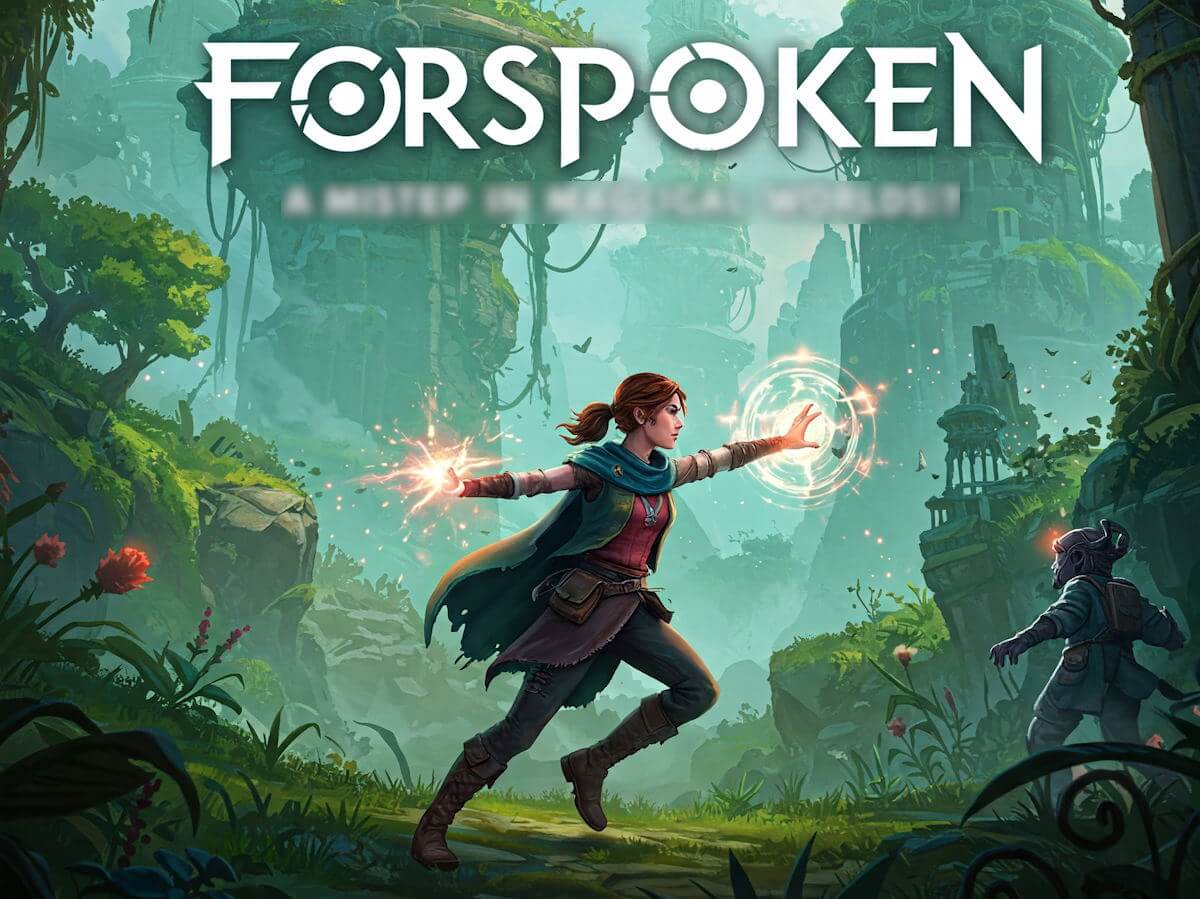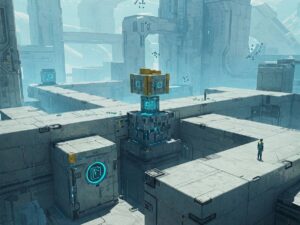Released in 2023, Forspoken is an action role-playing video game developed by Luminous Productions and published by Square Enix. Set in a richly detailed open world known as Athia, the game thrusts players into a fantastical realm filled with magic, danger, and intricate lore. The narrative follows the journey of Frey Holland, a young woman from New York City, who finds herself mysteriously transported to Athia. Here, she must navigate a land under siege by monstrous creatures and dark magic, while also grappling with her newfound powers.
Frey’s character is central to Forspoken, presenting an engaging blend of vulnerability and strength. As she explores the vibrant but perilous landscape, players witness her evolution from an ordinary young woman into a powerful warrior. This transition is facilitated by unique gameplay mechanics that emphasize fluid movement and exhilarating combat. The game’s emphasis on parkour-style traversal allows Frey to navigate the terrain with grace, making exploration an integral part of the gameplay experience. Players can seamlessly leap between cliff faces, dash across vast vistas, and scale ancient ruins, all while engaging in strategic combat against various foes.
The narrative of Forspoken also distinguishes itself through its incorporation of a companion, who serves as both a guide and a source of comedic relief. Known as Cuff, this sentient bracelet provides insights into Frey’s surroundings while adding a layer of personality to the story. The dialogue between Frey and Cuff enhances the overall experience, inviting players to delve deeper into the lore of Athia. The combination of a strong central character, innovative gameplay mechanics, and an intriguing story provides a solid foundation for an in-depth analysis of Forspoken’s strengths and weaknesses in the gaming landscape.
The World of Athia
The world of Athia serves as the expansive backdrop for the video game Forspoken, characterized by its stunning landscapes that blend both lush wildlands and treacherous terrains. Athia is designed to immerse players within a meticulously crafted universe, rich with lore and populated by various magical elements. This intricate design invites players to explore its vast environments, encouraging a sense of wonder and discovery that is essential in defining a strong fantasy world.
At the heart of Athia’s charm is its deep-rooted lore, which manifests through enchanting narratives woven into the game’s fabric. Each region within Athia is steeped in history, with ancient ruins and stories that tantalize players to delve deeper into the past of this realm. Such storytelling enhances the player’s engagement, creating an emotional connection with the world around them. Furthermore, Athia is replete with magical forces that influence not only the landscape but also the creatures and characters inhabiting it. These magical elements serve to shape gameplay mechanics, allowing for unique interactions and challenges that resonate with the fantasy genre.
The design of Athia fosters various player experiences, from exhilarating traversal mechanics that utilize the magical capabilities of the protagonist to the tactical engagements against formidable foes. As players navigate this enchanting environment, the expectations set by the game are both met and challenged, prompting a desire for exploration and mastery. In addition, the integration of nature, architecture, and magic culminates in a world that feels alive and reactive, enhancing the immersive quality of the game.
In conclusion, Athia stands as a testament to the potential of fantasy worlds in video games, demonstrating how design, lore, and magical elements coexist to create an engaging player experience. The world’s intricacies beckon players to lose themselves in its depths, illustrating the significance of a well-constructed fictional universe in shaping memorable gaming moments.
Gameplay Mechanics and Features
Forspoken features a unique combination of gameplay mechanics that interweave combat systems, movement dynamics, and the rich usage of magic. One of the most notable aspects is the fluidity of the movement, which allows players to traverse the expansive open world of Athia with agility. Players take on the role of Frey, who possesses an impressive range of magical abilities, permitting swift parkour-like traversal across various terrains. This movement mechanic not only enhances the exploration aspect but also integrates seamlessly into combat, creating dynamic encounters that require players to think on their feet.
The combat system in Forspoken is another defining feature, offering a variety of spellcasting options and hand-to-hand combat techniques. Players can choose from multiple spells, each providing distinct advantages, thus enabling a personalized approach to combat. These spells can be tailored to a player’s preferred playstyle, whether they favor aggressive tactics or more strategic, defense-oriented maneuvers. However, while the ability to equip and switch spells in real-time adds a layer of strategy, some players may find the reliance on cooldowns and resource management can occasionally interrupt the flow of battles. This factor can lead to frustration, especially during more intense encounters.
Additionally, the magic system is intricately designed, allowing for combos that blend movement and offensive capabilities. The aesthetic presentation of the spellcasting offers a visually captivating experience, contributing to the immersive quality of the game. Nevertheless, some criticisms have emerged regarding the depth of the magical systems—while they appear expansive, players may feel they lack meaningful engagement over extended play sessions. As such, the effectiveness of Forspoken’s gameplay mechanics often hinges on a balance of fluid movement, combat interactions, and the rewarding use of magic that keeps players engaged throughout their journey.
Narrative and Character Development
In the realm of gaming, narrative and character development serve as the backbone that enriches the player’s experience, which is a crucial factor in the title Forspoken. The protagonist, Frey Holland, embarks on a journey that is laden with personal growth and transformation. Her character arc begins with an uncertain and somewhat withdrawn individual who finds herself in a magically altered world. As the narrative unfolds, Frey’s interactions with the various supporting characters contribute significantly to her development. These relationships not only help to shape her identity but also serve as catalysts for her progression throughout the game.
The supporting cast, including figures such as Cuff—a sentient bracelet with a snarky personality—plays a pivotal role in driving the plot forward and enhancing Frey’s character. Their dialogues often reflect the game’s attempt to blend humor and seriousness, creating an emotional spectrum that resonates with players. However, while these interactions may initially engage players, some criticism has been directed toward their depth. The nuanced dynamics that are often expected in well-crafted narratives seem lacking at times, which could detract from the player’s overall experience.
Moreover, the overall plot development of Forspoken has been a point of contention among gamers and critics alike. The transition between various narrative arcs appears disjointed, at times struggling to maintain continuity. This disconnection can inhibit players from fully immersing themselves in Frey’s journey, leading to an inconsistent emotional engagement with her character and the world around her. While Forspoken aims to deliver a captivating narrative experience, the execution of character development and plot alignment must be critically evaluated to determine its success in contributing to the gameplay experience effectively.
Visual and Audio Design
The visual and audio design in Forspoken plays a critical role in shaping the player’s immersive experience within its fantastical world. The graphics are crafted with a high level of detail, capturing the vibrant landscapes and intricate character designs that the game has to offer. The art style employs a mix of realism and fantastical elements, allowing players to feel as if they have truly stepped into a realm where magic and adventure abound. However, while there are impressive moments of visual splendor, some players have noted inconsistencies in graphical fidelity that may momentarily draw them out of the experience.
One of the standout features of Forspoken is its dynamic environments, which can shift drastically as players progress through different regions. The attention to detail in the lush foliage, crumbling ruins, and otherworldly structures adds depth to exploration. Additionally, the implementation of light and shadow enhances the realism of the world, providing an engaging backdrop for the narrative. Nevertheless, there are instances where performance issues and frame rate drops detract from the overall visual experience, thereby affecting the player’s engagement with the story.
When it comes to audio design, Forspoken offers a compelling soundscape that complements its visual elements. The music, composed specifically for the game, enhances key moments in the storyline, providing an emotional resonance that aligns with character development. The voice acting is also noteworthy, featuring a cast that brings depth to their roles, effectively conveying the nuances of their characters’ journeys. However, critiques regarding the delivery and script have surfaced, indicating that some lines come across as cliché or lacking authenticity, which can detract from the narrative immersion.
Ultimately, the combination of visual and audio design in Forspoken contributes to a multifaceted experience. While there are significant strengths in graphics and sound, certain shortcomings may leave players yearning for a more polished presentation that fully realizes the potential of this magical world. As the game seeks to captivate players through its aesthetics, addressing these elements will be crucial for its ongoing appeal.
Critical Reception and Community Feedback
Upon its release, Forspoken garnered a diverse array of critical reviews and community feedback, reflecting a spectrum of opinions on its gameplay, narrative, and design elements. Critics were quick to note the game’s ambitious open-world mechanics and the innovative spell-casting system, which were largely praised for adding depth and creativity to gameplay. However, some reviewers expressed disappointment in the overall execution of these features, claiming that the gameplay mechanics often felt repetitive, detracting from the immersive experience that players expected from a game set in such a richly fictional universe.
The narrative structure also received mixed responses. While some players applauded the attempt to weave real-world themes into the storyline, others criticized it for lacking coherence and emotional depth. This dichotomy in opinions illustrates the challenges faced by developers in creating a compelling narrative that resonates with a broad audience. Fractured plot points and character development appeared to be a particular focal point of contention, leaving some players feeling disconnected from the protagonist’s journey.
Design elements, including graphics and environmental aesthetics, were another area of scrutiny. Many praised the visuals and the vibrant depiction of the magical world, which were seen as significant achievements. Nevertheless, a notable segment of the community raised concerns about performance issues that hindered the experience, particularly in terms of frame rates and loading times, leading to frustration during gameplay.
In summary, the reception of Forspoken showcases a complex blend of praise and criticism. While its innovative mechanics and visual design managed to captivate many, the underlying issues concerning gameplay repetition and narrative execution sparked considerable debate amongst gamers and critics alike. This divergence highlights the multifaceted nature of player engagement with contemporary gaming experiences.
Comparisons to Other Magical Worlds
In the realm of video games featuring magical worlds, Forspoken must contend with a multitude of successful titles that have set high standards for immersive storytelling and engaging gameplay. Games like The Legend of Zelda: Breath of the Wild and Final Fantasy XV have successfully woven rich narratives with expansive worlds that seamlessly integrate magic and adventure. These titles not only captivate players with their visual aesthetics but also develop the lore and depth of their magical realms.
Forspoken presents a contemporary narrative style and unique traversal mechanics that stand out in the genre. It notably introduces Frey Holland, a protagonist grappling with her new powers within a vibrant yet dangerous magical land. While the game offers a refreshing protagonist with distinct abilities, it often falters when compared to the profound character development seen in other titles. In contrast to characters in The Witcher series, who are often multifaceted and experience significant growth throughout their journeys, Frey’s character arc may not resonate as deeply with players, leading to questions about emotional investment in her story.
Furthermore, the game’s open-world design, while seemingly expansive, may feel less cohesive to players accustomed to the detailed environments of games such as Skyrim or Hollow Knight. These games not only house intricate quest lines and side missions but also invite exploration, rewarding players with hidden treasures and lore that enrich the overall experience. Forspoken, while ambitious, sometimes lacks this sense of discovery, which may detract from players’ engagement.
Ultimately, Forspoken showcases an innovative approach to magical gameplay, but it must strive to match the immersive qualities and character-driven narratives that define the best offerings in the genre. As players continue to seek out new adventures in magical worlds, their expectations remain shaped by the compelling successes of its predecessors.
Lessons Learned from Forspoken
Forspoken, a title that aimed to deliver a captivating fantasy experience, serves as an intriguing case study for game developers and the broader gaming community. One of the primary takeaways from Forspoken’s development and its subsequent reception is the significance of narrative cohesion. In a genre where storytelling is paramount, players expect a seamless integration of plot and gameplay. Forspoken’s narrative, while ambitious, struggled to maintain coherence, which ultimately led to a disconnect between the character’s motivations and player engagement. Future developers should prioritize crafting strong narratives that enhance player immersion.
In addition, the gameplay mechanics in Forspoken offer profound insights into player expectations. The game’s open-world design, accompanied by its parkour mechanics and magical combat system, showcased a desire for fluid navigation and dynamic combat. However, despite these innovative attempts, many players felt that the execution fell short. Hence, the lesson here is that while innovation is essential, developers must ensure that new mechanics align with intuitive user experiences. Striking the right balance between novelty and familiarity can greatly enhance player satisfaction and retention.
Lastly, player feedback is a critical aspect that cannot be overlooked. Developers of Forspoken did engage with the community, but the degree to which player insights influenced the final product was insufficient. Collectively analyzing user feedback during all stages of development can result in a more polished end product that resonates better with its audience. Building a game community that feels heard can foster loyalty and ultimately lead to a richer gaming experience. Consequently, integrating these lessons into future projects may result in improved outcomes in creating immersive magical worlds that delight players across diverse demographics.
Conclusion: The Future of Forspoken
The future of the Forspoken franchise remains a topic of intrigue among fans and industry observers alike. Despite the mixed reviews that the inaugural game received, it is essential to consider how the developers might leverage the lessons learned from player feedback to evolve the series. There is a clear opportunity for growth, particularly in enhancing gameplay mechanics, narrative depth, and world-building elements, which many players found lacking.
Potential updates could address some of the criticisms by refining the combat system and offering more varied quests that resonate with the player base. Expanding the storyline to include more intricate character development and emotional depth could also enhance the player experience, fostering a stronger connection to the universe of Forspoken. Additionally, inclusivity of player suggestions through patches or downloadable content could demonstrate the creators’ commitment to evolving the franchise based on community input.
Moreover, sequels are often shaped by the foundation laid in their predecessors, and Forspoken is no exception. If a follow-up is in the pipeline, the developers could explore new characters and magical abilities while ensuring that the world feels expansive and immersive. Utilizing advanced technologies and gameplay innovations can set the stage for a more captivating experience that aligns with the expectations of both new and returning players.
In summary, the future trajectory of Forspoken appears to hinge on the creators’ ability to listen to the audience’s feedback and refine the core elements that resonate with players. By embracing these insights, Forspoken can potentially evolve into a memorable franchise that captivates its audience for years to come, ultimately transforming its current standing in the gaming landscape. The journey ahead holds promise, contingent on the lessons learned from the initial release and the developers’ willingness to innovate and adapt.




